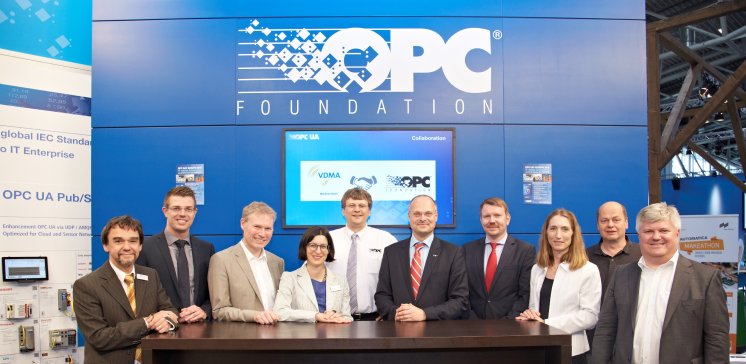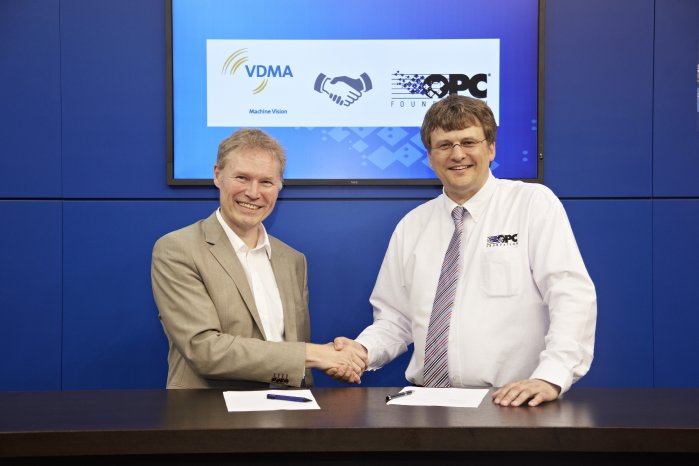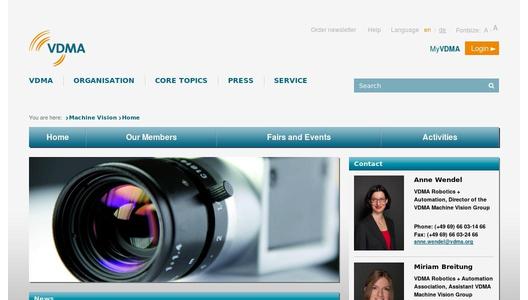Machine Vision – when machines see and comprehend
Machine vision systems have become an indispensable part of industrial production. They perform quality tests, guide machines, control processes, identify components read codes and deliver valuable data for optimizing production. No other current component in the production process gathers and interprets as many data as machine vision does. “In my view, it is a key technology for the successful implementation of Industry 4.0,” says Noffz, and Heinol-Heikkinen adds:
“Standardised integration of machine vision with all its possibilities will advance it from a mere inspection system to a genuine production optimiser.”
Stefan Hoppe, Vice President of the OPC Foundation, explains: “The OPC Foundation provides THE industrial interoperability standard for horizontal and vertical information integration from sensors to the enterprise. OPC UA’s initial focus was the industrial automation market and because OPC UA is completely vendor and operating system independent, it has quickly become the adopted
interoperability solution for other markets and domains. Machine and device manufacturers describe their data and interfaces and then configure the security credentials to make them available or keep them protected. Different transport mechanisms are integrated to move data and information best for
different scenarios for both the shop floor and also for cloud solutions. OPC UA technology has already been named the recommended communication technology in Germany’s Industrie 4.0 initiative. The German Federal Office for Information Security (BSI), thoroughly analyzed OPC UA data security and published a highly positive review. Many other organizations have taken advantage of the OPC UA information modeling capabilities allowing seamless information integration between previously disconnected systems. VDMA Machine Vision early recognized the
potential of OPC UA – the joint working group will create a companion specification which will enable camera vision systems to be easily and securely connected to controllers but also into the IT world.”
More and more VDMA trade associations focus on OPC Unified Architecture. A VDMA guideline “Industrie-4.0-Kommunikation mit OPC-UA” (Industrie 4.0 communication with OPC UA) is currently being prepared. It is intended to support the mechanical engineering industry in the integration process and provide recommendations for action. “With the guideline, we aim at giving a clear
endorsement for OPC UA as communication protocol for Industrie 4.0. This leads to lowering the barriers of small and medium-sized companies in the establishment and expansion of industrial communication within the Industrie 4.0 context.” says Dr. Christian Mosch of the VDMA Industrie 4.0 Forum.
About VDMA Machine Vision
The VDMA represents over 3,100 mainly small and medium size member companies in the engineering industry, making it one of the largest and most important industrial associations in Europe. As a part of the VDMA Robotics + Automation Association, VDMA Machine Vision unites more than 115 members: companies offering machine vision systems and components. The objective of this industry-driven platform is to support the machine vision sector through a wide spectrum of activities and services. Current activities include statistics and the annual VDMA Machine Vision Market Survey, marketing services, public relations, trade fair policy, future radar, networking events and conferences. Find out more about VDMA Machine Vision at:
www.vdma.com/vision.
Machine Vision Market Data
According to the latest VDMA market surveys, the sector turnover in Europe grew by 16% in 2014, with a further growth expectation of 11 percent in 2015.
The German machine vision industry increased its turnover by 16% in 2014 reaching the mark of € 1.9 billion. The growth impetus came mostly from exports: While domestic turnover grew by 12 percent, exports from Germany went up by 19 percent in 2014. The export share rose from 57 percent to a new all-time high of 59 percent. According to the latest monthly VDMA incoming order index for machine vision, the industry will achieve its forecasted turnover growth of 10 percent in Europe and in Germany, which will increase turnover of the German machine vision industry to over € 2 billion. In 2016, the industry expects to further expand their sales volume: in Germany, growth of 8 percent, and in Europe, growth of 7 percent is expected.



